Stamp Swap is from the designer of Honey Buzz and Genotype, Paul Salomon. Now, he brings stamp collecting to life with a fairly well designed game with some fun tiles to look at while playing. The game is designed for 1-5 players, and the game takes 30-60 minutes to play. You will be drafting items, making groups that might become yours or someone else’s, and then placing those items on a grid on your player board to score points. This is one of the newest titles from Stonemaier Games, and it might be worth your time to check out what this game offers.
What’s in the Box?
- 1 Game board
- 5 Player mats
- 165 Stamp tiles
- 19 Attendee cards
- 30 Contest cards
- 10 Event cards
- 5 Reference cards
- 10 Scoring cubes
- 15 Show tickets
- 1 First player token
- 1 Phase token
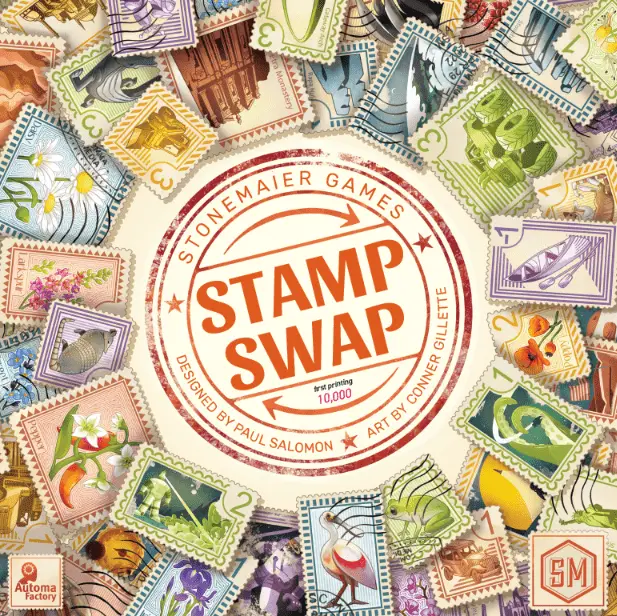
How’s it Play?
This is a mixture of a drafting game where you will be selecting tiles from man different sizes stamp tiles that have different colors, shapes, and themes. All of these similarities or differences between stamps also determine your scoring at the end of the game, so your drafting of tiles determines what you have at the end of the game to score points.
But that’s not all. The game then combines drafting with an “I cut, you choose” mechanic that has you make 2 groups of items, and someone most likely will take a group from you, while you keep the other group. But you also can choose a group from someone else. So you might get what you want, or you might not, depending on the groups you make.
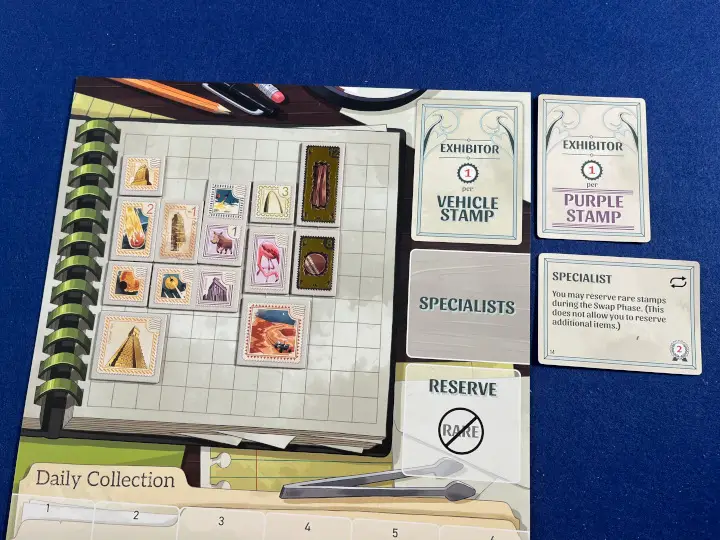
Lastly, the third major mechanic in this game blends in tile placement. You will be placing your stamps on a board, and you won’t be able to move them after placing them. Then, you want to group stamps to score points depending on the contest cards in the game. So again, drafting, “Cut, you choose”, and tile placement.
The three phases in the game are: Collect, Swap, and Show. You set up a round by drawing and revealing a number of event cards equal to the number of players in the game. You then randomly place out the shown items to form a market of sorts. This consists of mostly tiles and some cards. Each card has text on the bottom, but you only use the text on the bottom event card that is shown. This causes some condition to occur changing up the norm from round to round.
The collect phase then starts with the first player. They can select any one item in the market and place i on a number space on their player board. This continues with players taking items until everyone has 6 items. If you ever choose a face down stamp, you may look at it, but it remains face down. If you select a specialist, it becomes active when you select it. The other unique item is the first player token, which gives you a better draft order.
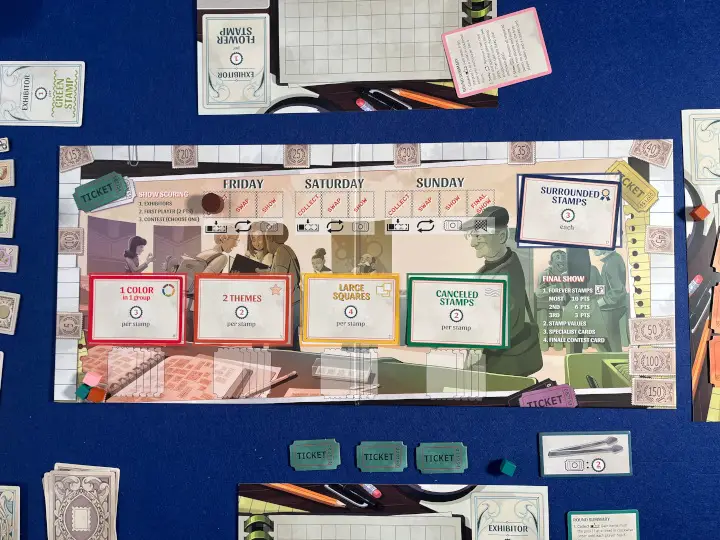
The swap phase occurs after players all have 6 items. Each player places one item in their reserve area. The reserve area means they automatically get this item. The 5 other items are then split into 2 groups. The first player then selects a group from another player, and places those items in their own supply. Then, the opponent takes the other pile to place in front of them, and then they choose a group from another player. This continues until each player has 2 groups.
Players add their item from their reserve, and then start the show phase by placing their stamps on their player board. You add cards to the right side of your board and place stamps on empty spaces within the grid. The placement of these stamps determines some of the scoring. Usually, you want to place stamps touching in some sort of positioning to fulfill a goal.
So, you score points for having forever stamps. The player with the most forever stamps scores the most points, and the player who has the least scores the least amount of points. You also score points from the values shown on your stamps. Specialist cards score 2 points each. Lastly, the contest cards score according to their requirements. The player with the most points then wins the game.
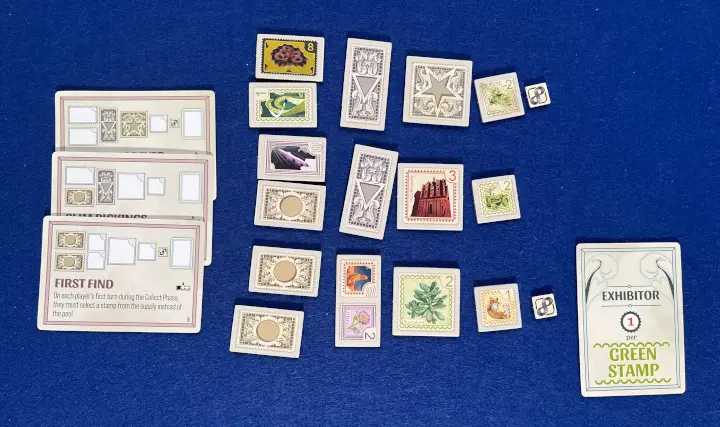
The Verdict
The biggest achievement of this game is the blend of mechanics it offers. The drafting, set collection, “I cut, you choose”, and tile placement each on their own is nothing special. But, the way this game uses them together really pumps up the game with strategy, hard choices, and a feeling that you WANT to give it another go.
You are thinking of a variety of different things you want on your board, with maybe something that matches a color, a theme, a size, or maybe you want that card that gives a good ability. Either way, you have a lot you are looking for. Once you gain some of it during the drafting, you need to realize that you won’t keep everything. You might not even keep what you want because someone else might take the pile that your really wanted. So maybe next time you split up your items so you have some items you want in both piles, or better yet, maybe you draft items someone else wants and make a pile that someone else can’t give up so you can take what you want in your pile. There is a lot to think about.
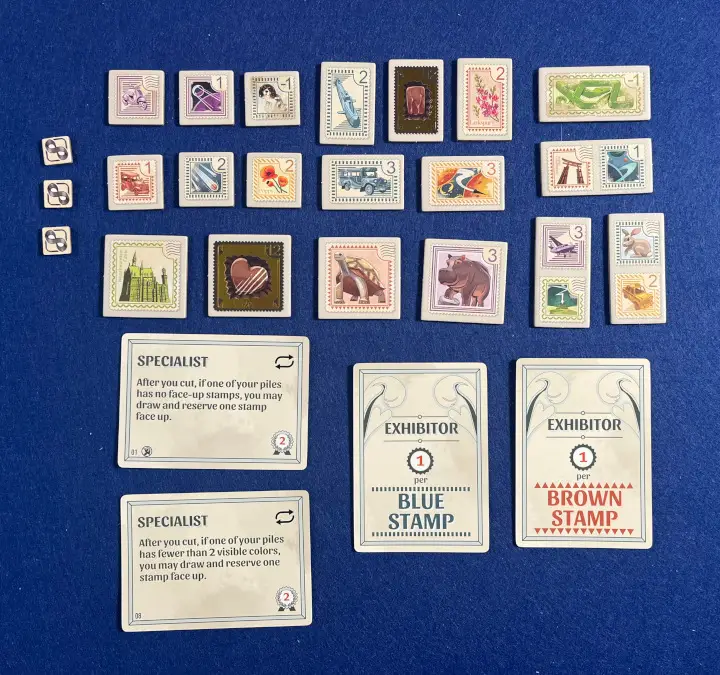
Then you are trying to figure out how to place them on your player board trying to, or maybe not to, connect certain items, or leaving space for something in the future. This is hard to do because you really don’t know what will come in the future to know what to keep space for, but you try.
The hardest part if figuring out which card to use your ticket on to score at the end of each round. At the end of the game, they all score, but as you go you only have so many items to score with, so your drafting might focus more on a scoring card for that round, and then another round might focus more on another one. You might have plans for one thing but then later realize that you can take some items from someone else to score better with another card. But once you use a ticket for one of those cards, you need to focus on the others for future rounds.
The components for the game are great. There might be some confusion with the symbols on the back to the tiles indicating different sized stamps, but you’ll figure those out with time. The player boards aren’t really boards, but rather flimsy paper, but it works the same. The art on the stamps is wonderful. I really like the way they did the foil for the rare stamps.
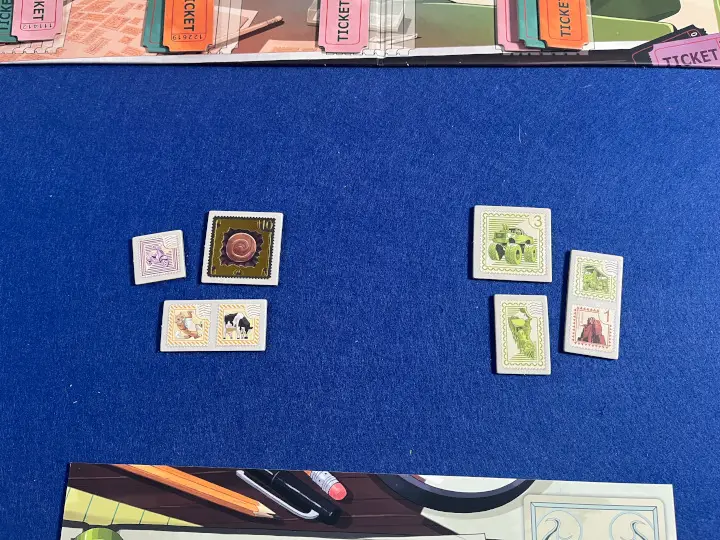
Lastly, there are plenty of cards to change the game every time you play, so you are not playing the same game each time. You are doing the same actions and choosing similar items, but the stamps or cards you want will be different every time you play the game. Also the setup with what types of items you choose from is random with the event cards that are used. Overall this is a good game, and it was the unique combination of mechanics that really made it shine.
Images via Stonemaier Games
Have strong thoughts about this piece you need to share? Or maybe there’s something else on your mind you’re wanting to talk about with fellow Fandomentals? Head on over to our Community server to join in the conversation!

